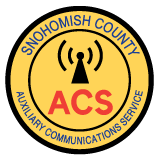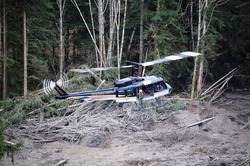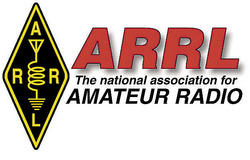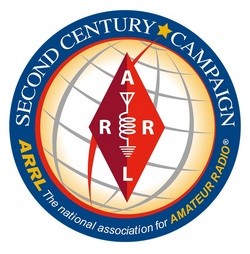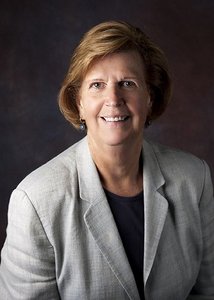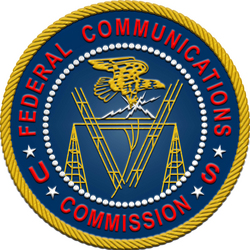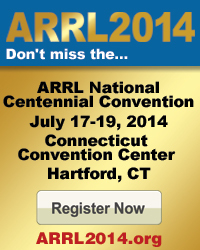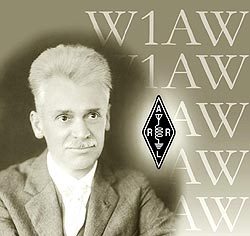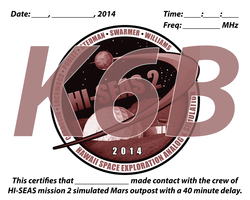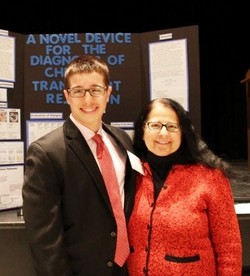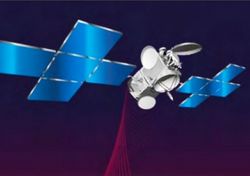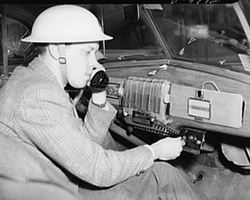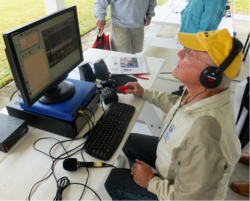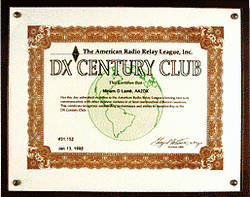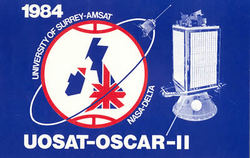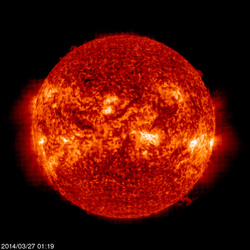 March 27, 2014 John E. Ross, KD8IDJ, Editor
| |||||||||||||||||||||
Amateur Radio, Federal Government Engaged in Joint 5 MHz Communication Exercise Amateur Radio operators and federal government stations are engaged in a 12-day nationwide test of their capability to communicate with each other on HF in the event of an emergency or disaster. The High Frequency Interoperability Exercise 2014 (HFIE-2014) is running concurrently with the federal National Exercise Program (NEP) 2014. Activity is taking place on two of the five 60 meter channels. The primary center-frequency channel is 5358.5 kHz, and the secondary center-frequency channel is 5373.0 kHz. Amateur Radio is secondary to government users on the band. The joint readiness exercise that began March 27 will continue through April 7 and include all areas of the US. Participants will use Automatic Link Establishment (ALE), a standardized digital selective calling protocol, to establish communication between stations.
"The HFIE has been a semi-annual exercise for some years," explained HFIE-2014 Coordinator Bonnie Crystal, KQ6XA. "Previously, HFIE has been a ham-only exercise. This year, we scheduled HFIE so it coincides with the NEP." Participation in the interoperability exercise is open to all ALE-capable federal government radio stations and to all ALE-capable US Amateur Radio stations. A Special Temporary Authorization (STA) has been granted, giving permission for radio amateurs to communicate with federal government stations for the duration of the exercise. Crystal said ALE signaling "sounds like turkey gobble," adding that ALE calls last about 15 seconds. Stations listening "may also hear the operators then start talking on USB voice," she said. "The signals can be up to about 40 seconds long, if there's texting riding on it, using a very rapid type of ARQ [automatic repeat request] handshaking." "Once someone links with another station, they have the choice of using SSB voice or sending/receiving up to about 80 characters of text," Crystal said. "Or they can switch to some other mode, such as CW or PSK or PACTOR." ARRL Regulatory Information Manager Dan Henderson, N1ND, said the exercise offers an excellent opportunity for those amateurs with ALE capability. "It is a good exercise that highlights one of the key elements under which US amateurs were granted secondary status on the 60 meter band," he said. "The amateur community's ability to participate in an interoperability exercise with governmental communications is a great way to assess where things stand in this area -- and to explore the next steps to take. We encourage those amateurs familiar with the ALE protocols and have the station equipment to participate in a meaningful way to do so." Read more. Public Service: Amateur Radio Volunteers Staff Shelters, EOC in Washington Landslide Response
Amateur Radio volunteers are on hand at the Snohomish County, Washington, Emergency Operations Center (EOC) and supporting communication with American Red Cross shelters set up in the wake of the disastrous and tragic landslide on March 22 near Oso. Snohomish County Auxiliary Communications Service (Snohomish ACS -- formerly RACES) Radio Officer Scott Honaker, N7SS, reported this week that his organization has been active "but at a fairly low level." "Because of the danger, only fire and search and rescue (SAR) are on scene, and only during the day," he reported March 24. Honaker said that even SAR teams were pulled back from the debris field earlier that day, after some movement of the remaining hillside had been detected. The response remains in rescue mode. Sheriff's helicopters have been crisscrossing the area, searching for any signs of life. Authorities have been telling area residents to stay away. Honaker said ACS volunteers have been coordinating their activities on the Granite Falls 146.92 MHz repeater and on cell phones. "Emergency Services Coordinating Agency (ESCA) RACES is active staffing the Red Cross shelters, and they are using our UHF ham repeater near Arlington (444.200 MHz)," he added. "We have been hearing good communications between the shelters." The ARC has established shelters for displaced residents in Arlington and in Darrington.
The slide swept a massive avalanche of trees, wet soil, rocks, and debris across the rural Northwest Washington community. It leveled about two dozen houses and blocked a mile-wide stretch of State Route 530. The governor's office quickly declared a state of emergency in Snohomish County. The landslide also blocked the North Fork of the Stillaguamish River near Oso, raising the threat of localized flooding. Authorities said on March 26 that 25 people lost their lives in the disaster, but they lowered to 90 the number of people who remain unaccounted for. Honaker said the slide damaged some communication infrastructure, and fire and law enforcement personnel have been using cell phones to keep in touch, with SAR and air operations utilizing VHF radios. "Snohomish ACS is staffing the EOC around the clock in Everett, and we have one member who lives in Darrington supporting the county command vehicle there," he said. "With the loss of phone lines to Darrington, there are no functional landlines or Internet access." He said the Darrington police and fire departments were using their command vehicle as an EOC, because it has working telephones as well as Internet service and computer-aided dispatch capability. "The Incident Management Team in Arlington is using the other command vehicle to provide communication support for the staff in the City Council chambers," he said. ARRL Western Washington Section Manager Monte Simpson, K2MLS, said this week that crews were working to restore the fiber optic cable in the area of the mudslide. "When that's completed, communications will be back on line," he said.
Honaker said he appreciates the many offers of support from hams within and outside the area -- more help than is needed at present. "It is good to see the community rally during these types of events," he said. Recent heavy rainfall is being blamed for the slide. "This is not a good situation," ARRL Northwestern Division Director Jim Pace, K7CEX, told ARRL Headquarters earlier this week. "Our ground out here is so saturated, it is a miracle that we haven't had more landslides." He anticipated that ARES/RACES activity could increase as the operation moves into the recovery phase. Public Service: Amateur Radio Credited in Rescue of Wayward Hikers Authorities in Kern County, California, say Amateur Radio was responsible for the rescue of five adult hikers, who became lost in San Emigdio Canyon. The group had left Pine Mountain Club on the morning of Saturday, March 22, hiking to a vehicle parked near Highway 166 when they went astray. "They had hand-held radios with them and called an Amateur Radio operator in Pine Mountain Club to report [they were] lost," a Kern County Sheriff's Department summary said. "Air-1 quickly located the lost hikers in a dry creek bed, approximately 12 miles south of Highway 166, and a ground unit transported them to their vehicle." The sheriff's office said the hikers, who had plenty of food and water, "were extremely exhausted, but did not require medical aid." In the hiking party were Cliff Brunk, K8BUW, and his wife Judith, KG6BXM. According Don Quick, KW6PMC, who knows the couple, Cliff Brunk -- who was carrying a hand-held transceiver -- fell and struck his head. While not seriously injured, he was in pain. At that point, the group decided to return home, but then realized they were lost and outside of cell phone range. Using his radio, Brunk was able to reach Bill Hopper, AB6CF, via the Pine Mountain repeater, Quick said. The injured ham reported the hiking party's predicament but couldn't provide details regarding their location. Another member of the party was able to pass along the group's location, however, and Hopper called 911. The Kern County Sheriff's Department dispatched a helicopter, which was able to locate the hiking party, but the nearest landing site was too far away for the rescue party to communicate with the hikers. A sheriff's deputy drove into the canyon near the spot where the hikers were stranded, and they walked to his patrol car. The weary hikers got back to their homes late that evening. -- Thanks to Donald Quick, KW6PMC, and the Kern County Sheriff's Department Your League: ARRL Executive Committee to Meet in St Louis The ARRL Executive Committee will face a full and challenging agenda when it gathers March 29 in St Louis, Missouri. A number of FCC and regulatory-related issues are up for discussion among the panel members.
One item that will come under intense EC scrutiny is the Petition for Rule Making (RM-11715) from Mimosa Networks that asks the FCC to create a Part 90 mobile allocation in the 10.0-10.5 GHz band. Mimosa has proposed to include a requirement for wireless broadband service operation in the band "to avoid harmful interference with Amateur service and Amateur-Satellite service operations in the band" but there are a number of aspects of the petition that raise concerns. At this meeting the EC will determine the general thrust of the ARRL's comments, which will be drafted for filing by the April 10 deadline. The EC also will discuss the Report on FCC Process Reform (GN Docket 14-25) and consider draft comments in response to the Commission's Public Notice on the subject. Comments are due March 31. The FCC Report proposes more than 150 process reform recommendations that cover a wide range of specifics. "These recommendations, if implemented, would enable the Commission to work faster, smarter, more efficiently, more transparently, and more inclusively," the FCC Public Notice stated. Additional discussion topics will include the League's March 12 complaint to the FCC contending that a "grow light" ballast being widely marketed and sold is responsible for severe interference on the MF and HF bands. The League urged Commission action to halt sales of the Lumatek LK-1000 electronic ballast and to recall devices already on store shelves or in the hands of consumers. The League's filing includes the results of tests that were conducted in the ARRL Lab in response to complaints from members. The EC also will review comments, reply comments, and post-comment period input from members on the League's Petition for Rule Making (RM-11708) to delete restrictions on symbol rates for data communication and to establish in their place a 2.8 kHz maximum occupied bandwidth for data emissions below 29.7 MHz. The EC will consider revisions to the 2009 Mobile Amateur Radio Operation Policy Statement -- in light of Moving Ahead for Progress in the 21st Century Act (MAP-21) requirements -- as well as state legislative issues affecting Amateur Radio. In MAP-21 Congress included funding for a new program encouraging states to enact and enforce distracted driving laws. It became law in 2012. Distracted driving legislation was the topic of the "It Seems to Us" editorial in the November 2013 issue of QST. Other items on the agenda for updates or reports include:
Voting members of the ARRL Executive Committee are President Kay Craigie, N3KN; Central Division Director Dick Isely, W9GIG; Hudson Division Director Mike Lisenco, N2YBB; Midwest Division Director Cliff Ahrens, K0CA; Pacific Division Director Bob Vallio, W6RGG, and West Gulf Division Director Dr David Woolweaver, K5RAV. Non-voting members are First Vice President Rick Roderick, K5UR, and Chief Executive Officer and Secretary David Sumner, K1ZZ. Your League: Challenge Fund Helping ARRL Second Century Campaign to Engage Amateur Radio's Future
Like the Roman god Janus, the ARRL Second Century Campaign is reflecting on the League's 100 years of service to the Amateur Radio community, while looking forward to paving a path to passionate involvement for new generations of hams. As it heads into the unknown of its second century, the ARRL is gearing up to face new and ongoing challenges -- among them, spectrum protection; inspiring and educating new hams; licensing, and promoting new technology and techniques. Maintaining a commitment to Amateur Radio comes with a cost, and today's hams are already helping. Until July 1, contributions to the ARRL Second Century Campaign will be matched dollar for dollar from the $250,000 Valentine Challenge Fund, thanks to the generosity of Mike Valentine, W8MM. "The notion of taking a leap of faith into the future can be scary to imagine, as it must have been for the League's founders, Hiram Percy Maxim and Clarence Tuska," said ARRL Chief Development Officer Mary Hobart, K1MMH, who expressed appreciation for Valentine's generosity. "Who knows what issues we will face, or where radio and wireless technology will take the next generation?"
But Hobart is certain of one thing: Amateur Radio has meant a great deal to many people. "Its history is filled with stories of science and service," she said. "What better way to celebrate the accomplishments of the first 100 years by investing in our future, even though the shape of that future is as yet unknown? Like Maxim and Tuska, we must have faith that those that follow us will have the same tenacity, vision and enthusiasm as past generations." Hobart said that as of February 28, ARRL had received more than $6.1 million in gifts and commitments. The goal of the ARRL Second Century Campaign is to raise $10 million to build the League's endowment and ensure a solid financial footing for the League's next 100 years of serving Amateur Radio. Hobart said all contributions are welcome. She encourages ARRL members to consider regular monthly installments, which can make contributions easier to manage. "One of our donors is giving monthly for 5 years!" she pointed out. She also urged ARRL members to consider the Second Century Campaign in their estate planning. A pledge form and more information are on the ARRL Second Century Campaign website. Read more. Regulatory: Radio Amateur Facing Substantial Fine for CB Violation An Oklahoma Amateur Extra class licensee is facing a $12,000 fine for operating his Citizens Band radio to "interfere with the communications of other CB stations," the FCC said in a Notice of Apparent Liability for Forfeiture (NAL) released March 21. In May 2013 an FCC agent used mobile direction-finding techniques to positively identify the source of a continuous carier of CB channel 19 (27.1850 MHz) to the residence of Orloff Haines, KF5IXX, in Enid, Oklahoma. Haines was not at home, but his wife showed the agent her husband's CB station, which was transmitting on channel 19.
"Mrs Haines stated that Mr Haines was 'keyed on,' or continuously transmitting on channel 19, because other CB operators in the area were harassing her," the FCC reported in the NAL. The agent telephoned Orloff Haines during the station inspection, and, the FCC said, he admitted that he was transmitting a continuous carrier on channel 19. Mrs Haines "voluntarily turned off" the CB transmitter at the end of the inspection. The FCC said the carrier was interfering with CB communication within an approximately 2 mile radius. Prior to last May, Haines had received two written warnings from the Dallas FCC office, advising him of the consequences of intentionally interfering with other CB communications. "The fact that Mr Haines interfered with other CB communications despite being twice warned in writing that such actions violated [the Communications Act] and FCC rules demonstrates a deliberate disregard for the Commission's requirements and authority," the FCC said, in justifying an upward adjustment of $5000 in the proposed forfeiture. The FCC gave Haines 30 days to pay the fine or file in writing for reduction or cancellation of the proposed fine. ARRL Centennial Station Giveaway! The ARRL has announced a "Centennial Station Giveaway" as part of its National Centennial Convention in Hartford, Connecticut, July 17-19, 2014. Sponsored by the ARRL and R&L Electronics, the first-prize winner will receive a Grand Prize voucher worth up to $5000 of equipment -- radio, antenna, and accessories -- redeemable for products sold by R&L Electronics. A second-prize winner will receive a $2500 prize voucher for products sold by FlexRadio Systems, also co-sponsored by ARRL.
All paid convention registrants will be entered in the prize drawings (door prizes). Winners will be drawn from among eligible registrants at the end of the convention on Saturday, July 19, 2014. The winner does not need to be present during the drawings. Three-day convention tickets are $75 and include an all-day training workshop and lunch on Thursday. Two-day tickets are $25 ($30 at the door), good for admission on Friday and Saturday. Everyone who attends the convention must register. ARRL Centennial: Centennial Operations in Iowa and Vermont until April 2 (UTC) The ARRL Centennial "W1AW WAS" operations taking place throughout 2014 from each of the 50 states now are in Iowa (W1AW/0) and Vermont (W1AW/1). They will relocate at 0000 UTC on Wednesday, April 2 (the evening of April 1 in US time zones), to Pennsylvania (W1AW/3) and Oregon (W1AW/7). During 2014 W1AW will be on the air from every state (at least twice) and most US territories, and it will be easy to work all states solely by contacting W1AW portable operations.
In conjunction with the 100th anniversary of the ARRL, the ARRL Centennial QSO Party kicked off January 1 for a year-long operating event in which participants can accumulate points and win awards. The event is open to all, although only ARRL members and appointees, elected officials, HQ staff and W1AW are worth ARRL Centennial QSO Party points. Working W1AW/x from each state is worth 5 points per contact. To earn the "Worked all States with W1AW Award," work W1AW operating portable from all 50 states. (Working W1AW or W100AW in Connecticut does not count for Connecticut, however. For award credit, participants must work W1AW/1 in Connecticut.) A W1AW WAS certificate and plaque will be available (pricing not yet available). The ARRL has posted an ARRL Centennial QSO Party leader board that participants can use to determine how many points they have accumulated in the Centennial QSO Party and in the W1AW WAS operations. Log in using your Logbook of The World (LoTW) user name and password, and your position will appear at the top of the leader boards. Results are updated daily, based on contacts entered into LoTW. Special Event: HI-SEAS Mission Team Set for Mars "Landing" on March 28
Ron Williams, N9UIK, and his fellow "astronauts" are set to "land on Mars" on March 28. Williams is part of Mission 2 (of four) in the Hawaii Space Exploration Analog and Simulation -- HI-SEAS -- project. The team is taking ham radio along to their simulated Martian outpost, a self-contained domed shelter, where they'll be cut off from civilization until mid-summer. They will begin their ham radio special event from their quarters on "the Red Planet" -- actually in Hawaii -- starting on April 12 at 1900 UTC. "We will continue to do this weekly for the duration of the mission or until interest wanes," Williams said. Their plan calls for simulating the communication delay that would occur over the distance from Mars to Earth, as required by the project's NASA sponsors. This will mean integrating a 20 minute signal delay into all communications, whether via Amateur Radio or the Internet. "To the best of our knowledge, this will be unique to any Amateur Radio special event ever conducted," Williams told ARRL in February. "Learning how to deal with signal delay is something that NASA is very interested in. The team was able to obtain the special event call sign K6B for the project for nearly the entire length of the mission, instead of the typical 15 days.
Every Saturday morning at 1900 UTC (0900 Hawaii Time), K6B will call out on an EchoLink repeater and on 10 meters, to offer information regarding the project and to invite calls. "We will stop transmitting and will turn off our receiver," he said. "During the following 20 minute 'signal delay,' an outside coordinator will line up individual hams wishing to make contact with us. At the end of 20 minutes we will turn our radio back on and begin receiving transmissions." These will be called in order by students at Hawaii Preparatory Academy, KH6HPA. After logging the call signs, the "Martian" team will wait another 20 minutes before transmitting acknowledgements. A special QSL card will be available. Williams said operational details will be announced as they become available. The HI-SEAS participants will simulate living and working within a Martian outpost -- a solar-powered dome at a remote site some 8000 feet up on the slopes of Mauna Loa. The experiment is being conducted by the University of Hawaii and Cornell University. At 60, Williams, a clinical neuropsychologist from Indiana, is the oldest member of the team and one of two hams on this crew increment. The other is Ross Lockwood, VA6RLW, of Alberta. People: Maxim Inventive Genius Lives On First-place 2014 Maine State Science Fair winner Demetri Maxim, the great-grandson of ARRL co-founder Hiram Percy Maxim, W1AW, apparently inherited some of the Maxim line's inventive genius. Demetri Maxim, 16, lives in Carlisle, Massachusetts, and attends Gould Academy in Bethel, Maine.
His prize-winning invention, which he has submitted for a patent, is aimed at developing a simple, non-invasive test to help kidney transplant patients, such as his own mother, Lefki Michael-Maxim, who must undergo repeated testing to determine if she is rejecting the transplanted organ. His invention "tests the level of protein in a patient's blood by inducing a reaction between the blood and other chemicals in a tiny test tube," the Bangor Daily News reported March 24 in a story by Nell Gluckman. The color resulting from the reaction indicates possible rejection. Demetri was one of 150 students taking part in the science fair March 22, sponsored by Jackson Laboratory in Bar Harbor, Maine, and judged by scientists from the world-famous genetic research facility. Demetri's great-great grandfather -- HPM's father -- was famous in his own right. Sir Hiram Stevens Maxim, born in Sangerville, Maine, invented the Maxim machine gun. HPM, among other things, invented the Maxim silencer as well as a muffler for gasoline engines. Ham Radio in Space: Qatar's Es'hailSat 2 Satellite to Carry Amateur Radio Transponder Qatar's Es'hailSat 2 satellite will provide the first Amateur Radio geostationary communication capability linking Brazil and India. The satellite, expected to launch by the end of 2016, will carry two "Phase 4" Amateur Radio transponders and will be positioned at 26° E. It will also carry Ku and Ka band capabilities for television, government, and commercial content distribution.
AMSAT-DL is providing technical support to the project. AMSAT-DL President Peter Guelzow, DB2OS, said the satellite's footprint will cover Europe, Africa, and parts of Brazil and Asia but not North America. "Basically [it will be in] the same position as Es'HailSat-1," Guelzow said. "Perhaps we will find another one willing to sponsor a position more in the West." AMSAT-DL plans to publish additional details on the satellite's technical characteristics in the next month. The Qatar Amateur Radio Society and Qatar Satellite Company are cooperating on the ham radio project. Feature: A Century of Amateur Radio and the ARRL In 1940 and 1941, the US Army continued its road to full mobilization, holding large-scale "maneuvers" in various parts of the country. The Army needed more frequencies on HF, and plans were made to turn over the entire 80 meter band to the Army. In return, US hams were allowed to use voice on 40 meters for the first time. Then, on December 8, 1941, President Franklin D. Roosevelt delivered his famous "date which will live in infamy" speech, asking Congress to declare war against Japan. Soon, the US was fully involved in World War II. Amateurs were immediately ordered off the air, with a special exception for W1AW to alert the few hams who were unaware of the FCC order. On January 10, 1942, all stations, including W1AW, were put off the air for the war's duration. ARRL continued to lobby for permission for hams to operate for civil defense purposes, however.
In June 1942, the FCC established the War Emergency Radio Service (WERS). It allowed radio amateurs to supply communication for their communities. An interesting sidelight is that the Government Printing Office was so overwhelmed at the time that the WERS order and information were promulgated via the ARRL and QST. ARRL again offered its and its members' support to the war effort, but this time, Amateur Radio had become a well-known and respected entity within government circles, and the government quickly took advantage of the offers. Because radio manufacturers weren't able to keep up with the military's demands for new equipment, the ARRL put together lists of equipment that hams were willing to sell to the government. Many hams volunteered for military duty, and more than a few times a newly sworn-in military operator would find himself sitting down in front of the equipment he had recently sold to the government! By March 15, 1942, about 15,000 hams were known to be in the military. Many other hams were working in critical defense jobs. Once again, hams answered the call! The ARRL and QST were soon working hard to issue publications used by the military, by training schools, and by radio clubs throughout our country to train more radio operators and repairmen. In addition, the ARRL started making plans to ensure the reappearance of Amateur Radio after the war ended. Next week: We'll continue with the story of US hams in World War II. In Brief
ARRL Seeks Candidates for Contest Branch Manager: The ARRL is seeking candidates for the position of Contest Branch Manager. This individual will be responsible for all aspects of ARRL's contest program. Applicants should have at least 5 years of experience in personnel, software, and process management in a non-profit environment and as an active Amateur Radio contesting participant. A bachelor's degree is preferred. Details are on the ARRL website.
Florida Community Event Demonstrates the Value of Ham Radio: The annual "Radio Day" event in the Florida community of The Villages has proven to be terrific publicity for Amateur Radio. An article about the February 26, 2014, event appeared in The Villages Daily Sun. The 150-member Villages Amateur Radio Club sponsors Radio Day, which shows the general public how Amateur Radio can provide emergency communication and hopes to spark interest among newcomers to ham radio. ARRL Contributing Editor Al Brogdon, W1AB, attended this year's Radio Day. "About 40 club members and another 40 non-hams showed up for the show-and-tell," he reported. "In addition to the excellent newspaper coverage, a photographer for the on-line Villages-News.com covered Radio Day. The club scored big points with good publicity for Amateur Radio!" He said the Villages ARC also will be on the air during Field Day as K4VRC. -- Al Brogdon, W1AB
TN2MS Operation Approved for DXCC Credit The ARRL DXCC Desk has approved the October 12-24, 2013, operation of TN2MS -- Republic Of The Congo -- for DX Century Club credit. If a request for DXCC credit for this operation has been rejected in a prior application, contact ARRL Awards Branch Manager Bill Moore, NC1L, to be placed on the list for an update to your record. Please note the submission date and/or reference number of your application in order to expedite the search for any rejected contacts. DXCC is Amateur Radio's premier award that hams can earn by confirming on-the-air contacts with 100 DXCC "entities," most of which are countries in the traditional sense. You can begin with the basic DXCC award and work your way up to the DXCC Honor Roll. Learn more. -- ARRL Awards Branch Manager Bill Moore, NC1L "Ham Video" Blank Transmissions to End March 31: The "Ham Video" digital Amateur Radio TV transmitter aboard the International Space Station is transmitting a continuous "blank" image (no audio) in configuration 4, on 2395 MHz. Due to the SpaceX docking and related ISS operations, Ham Video blank transmissions will end March 31. The last commissioning step will be planned in April or in May 2014. -- Gaston Bertels, ON4WF, AMSAT-EU Chair
OSCAR-11 Celebrates 30 Years in Orbit: OSCAR-11 has been in orbit for 30 years, and at least one beacon continues to transmit, albeit with a signal that grows ever weaker. Also known as UOSAT-2, OSCAR-11 was designed and built by a team at the University of Surrey in England. It was launched from Vandenberg Air Force Base in California on March 1, 1984. OSCAR-11 was the first amateur satellite to carry a digital communication package into Earth orbit. The satellite had beacons in three Amateur Radio bands -- 145 MHz, 435 MHz, and 2.4 GHz. Only the 145.826 MHz FM AFSK 1200 bps ASCII telemetry beacon remains in operation. The K7RA Solar Update Solar activity increased over the past week, with average daily sunspot numbers rising from 129 to 135.6, while average solar flux increased by nearly 13 points to 154.3. This compares the recent March 20-26 period with the previous 7 days, March 13-19.
The latest predicted solar flux from the current 45 day forecast has 10.7 cm flux values at 160 on March 27-29, 155 on March 30-31, 150 on April 1, 145 on April 2-4, 150, 155 on April 5-6, 160 on April 7-8, 155, 150, 145, and 140 on April 9-12, 145 on April 13-14, and 150 on April 15-17. Predicted planetary A index is 5 on March 27-April 8, 10 on April 9, 5 on April 10-16, then 8, 7,7, 10, and 8 on April 17-21, then 5 until April 25, when for 3 days the planetary index is 8 on April 26-28. This weekly "Solar Update" in The ARRL Letter is a preview of the "Propagation Bulletin" issued each Friday. The latest bulletin and an archive of past propagation bulletins is on the ARRL website. In tomorrow's bulletin look for an updated forecast and reports from readers. Send me your reports and observations. Just Ahead in Radiosport
Visit the Contest Corral for details. Upcoming ARRL Section, State and Division Conventions and Events
Find conventions and hamfests in your area.
ARRL -- Your One-Stop Resource for Amateur Radio News and Information Join or Renew Today! ARRL membership includes QST, Amateur Radio's most popular and informative journal, delivered to your mailbox each month. Listen to ARRL Audio News, available every Friday. Subscribe to... NCJ -- National Contest Journal. Published bi-monthly, features articles by top contesters, letters, hints, statistics, scores, NA Sprint and QSO Parties. QEX -- A Forum for Communications Experimenters. Published bi-monthly, features technical articles, construction projects, columns and other items of interest to radio amateurs and communications professionals. Free of charge to ARRL members: Subscribe to the ARES E-Letter (monthly public service and emergency communications news), the ARRL Contest Update (bi-weekly contest newsletter), Division and Section news alerts -- and much more! Find us on Facebook. Follow us on Twitter.
| |||||||||||||||||||||

